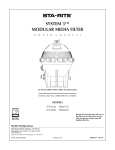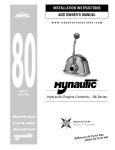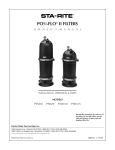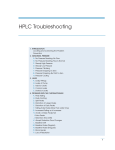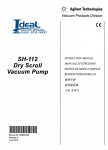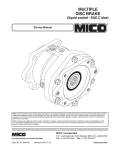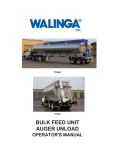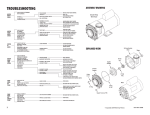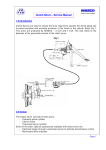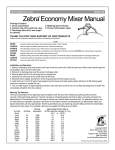Download Dual Cable Lock Installation and Service Instructions
Transcript
DUAL CABLE LOCK Installation and Service Instructions Brake Fluid Model Numbers 02-640-169 02-640-201 Mineral Based Hydraulic Oil Model Number 02-640-202 READ GENERAL INSTALLATION GUIDELINES SHEET (FORM NO. 81-600-001) BEFORE PROCEEDING 1. All MICO locking devices are supplemental safety equipment which provide additional brake holding action when used with existing vehicle parking brake. 2. The Low Pressure Warning Switches must be used in combination with an audible or visual alarm to signal any loss of system pressure. The Low Pressure Warning Switches are explained in the Operating Instructions (Form No. 81-660-016). Do not disconnect Low Pressure Warning Switches. 3. All lines, fittings and adjacent areas must be cleaned of dirt or road residue before any lines or fittings are disconnected. Special care must be taken so dirt and road residue are not allowed to enter hydraulic brake system. This can contaminate the system and interfere with proper operation of brakes and MICO locking devices. 4. Follow procedures outlined in Vehicle Manufacturer’s Service Manual or SAE Standards when making new connections or adding to existing brake systems. Use only steel brake tubing conforming to SAE specifications. 5. Use only brake fluid conforming to latest SAE or DOT Standards. Improper or contaminated brake fluid may cause gummy deposits and softening and swelling of other rubber seals in the entire brake system. Such a condition must be corrected immediately. 6. Do not use sealants, tapes, teflon or cement compounds on any connections or fittings. These sealants or compounds can contaminate the hydraulic brake system and interfere with the operation of brake components or MICO locking device. 7. All fittings and connections must be in good condition and tightened to proper torque values as specified in the Installation and Service Instructions. 8. Separate models of MICO locking devices are available for brake fluid and for mineral based hydraulic oil. Select model to conform with the type of fluid in system. 9. Brake hoses, brake lines, MICO locking device, brake components, cylinders, and all fittings must be routinely inspected for leaks, damage or wear. Adequate fluid levels must be maintained. In the event of any loss of fluid, brake system must be carefully inspected for leaks. 10. After installation, bleed system according to vehicle manufacturer’s recommendations. 11. Follow INSPECTIONS and TESTS section as outlined in the Operating Instructions. 12. The self-adhesive warning label accompanying each MICO locking device must be affixed in cab in view of operator. 13. The Operating Instructions must be placed in cab of vehicle in a place available to operator. MICO could not possibly know of and give advice with respect to all conceivable applications in which this product may be used and the possible hazards and/or results of each application. MICO has not undertaken any such wide evaluation. Therefore, anyone who uses an application which is not recommended by the manufacturer, first must completely satisfy himself that a danger will not be created by the application selected, or by the particular model of our product that is selected for the application. MICO has made every attempt to present accurate information in catalogs, brochures and other printed material. MICO can accept no responsibility for errors from unintentional oversights that may exist. Due to a continuous program of product improvement, materials, specifications, and product documentation are subject to change without notice or obligation. MICO is a trademark and registered trademark of MICO, Inc. MICO is registered in the U.S. Patent and Trademark Office as well as in Australia, Canada, Indonesia, Japan, Peoples Republic of China, South Korea, and the European Community. MICO, Incorporated Innovative Braking and Controls Worldwide Form No. 81-660-015 Revised 2008-12-03 1911 Lee Boulevard / North Mankato, MN U.S.A. 56003-2507 Tel: +1 507 625 6426 Fax: +1 507 625 3212 www.mico.com MOUNTING DUAL CABLE LOCK The dual cable lock is remote mounted with a cable which should be located in cab for operator’s convenience. 12. Position operating arm in unlocked position. Push knob to within 1/4 inch of fully closed position and trim inner core 1/2 inch beyond clamp, then tighten set screw. Tubing is not supplied because of the variation in each installation. Install tubing using shortest and most protected route. Use same size tubing when replacing a line, unless otherwise specified. Thoroughly inspect port threads for any foreign material after removing vinyl plugs. Bleeder screws provided must be used on installation. After installation, dual cable lock may contain air. This air, if not removed, will cause an ineffective and perhaps inoperative brake system. FIGURE 2 1. Locate dual cable lock on inside or outside of frame rail. Be sure that the lock does not interfere with the other vehicle components, (See Figure 1). 2. Using the dual cable lock mounting bracket as a template, drill necessary mounting holes. 3. Install bolts, lock washers, and nuts. FIGURE 1 FIGURE 3 RECOMMENDED ACTUATOR MOUNTING LOCATION INSIDE OR OUTSIDE FRAME RAIL TORQUE SPECIFICATIONS All hydraulic line connections must be torqued to specifications listed below and be free of leakage. CABLE CONTROL ASSEMBLY INSTALLATION (Figures 2 & 3) 1. Drill 1/2 inch hole in dash panel (universal mounting bracket may be used instead). 2. Remove knob and lock nut from cable assembly. 3. Remove first 1/2 inch nut from cable assembly, leaving lock washer and second 1/2 inch nut on assembly. 4. Insert threaded end of cable through 1/2 inch hole from backside of dash panel. 5. Replace and tighten 1/2 inch nut securing cable to dash. Torque nut 16.3-23.1 N·m (12-17 lb·ft). 6. Replace lock nut and knob allowing 1/4 inch clearance between lock nut and first 1/2 inch nut. 7. Insert cable through firewall and route to cable clamp attached to dual cable lock. Avoid sharp bends and kinks. 8. With cable held in position, move knob and check for binding. If binding is present, reposition cable. 9. Remove inner core and trim outer sheath of cable to fit. 10. Insert end of sheath into cable clamp on dual cable lock and tighten. Install rubber boot on outside of cable housing, slide on at least 1/4 inch. 11. Insert inner cable core and feed through core clamp on operating arm of dual cable lock. MICO, Inc. Thread Size Torque 3/8-24 7/16-24 1/2-20 9/16-18 10.9-20.3 N·m (8-15 lb·ft) 16.3-23.1 N·m (12-17 lb·ft) 16.3-23.1 N·m (12-17 lb·ft) 20.3-33.9 N·m (15-25 lb·ft) CONNECTING THE BRAKE LINES (Figures 4, 5, 6, 7, 8 & 9) For all brake systems in use today, including antilock, the MICO Dual Cable Lock must be installed between last hydraulic component in supply line and wheels. (2) Form No. 81-660-015 Revised 2008-12-03 Dual System - Lock Installed Dual System - Existing Warning/Proportioning Valve and Rear Anti-Lock Control Valve may not be used in some Dual Systems. FIREWALL MOUNTED BOOSTER FIREWALL MOUNTED BOOSTER FIGURE 4 FIGURE 5 3-Channel Anti-Lock System - Existing 3-Channel Anti-Lock System - Lock installed REMOTE MOUNTED BOOSTER REMOTE MOUNTED BOOSTER FIGURE 6 FIGURE 7 4-Channel Anti-Lock System - Existing 4-Channel Anti-Lock System - Lock Installed FIREWALL MOUNTED BOOSTER FIREWALL MOUNTED BOOSTER FIGURE 8 FIGURE 9 Form No. 81-660-015 Revised 2008-12-03 (3) MICO, Inc. BLEEDING PROCEDURE CONNECTING HORN RELAY AND LOW PRESSURE WARNING SWITCHES See General Guidelines Sheet (Form No. 81-600-001) for bleeding guidelines. The hydraulic brake system must be bled whenever any line has been disconnected. There are two methods of bleeding hydraulic systems, pressure bleeding and manual bleeding. Both methods are acceptable and adequate but pressure bleeding is recommended if the equipment is available. Follow bleeding procedure and instructions as specified by vehicle manufacturer. (Figure 10) If the vehicle does not have an auxiliary horn relay, install one as shown. The auxiliary horn relay must be used when the electrical load exceeds 3 amps. Do not make connections from warning circuit directly to battery terminal as pressure switch contacts will be damaged. Use only Brake Fluid SAE J1703 or DOT Brake Fluid or brake fluid specified by the vehicle manufacturer. Never reuse brake fluid that has been drained from the system. Before moving vehicle, a firm pedal must be achieved when dual cable lock is in full release position. If a firm pedal is not achieved, repeat bleeding procedure for dual cable lock and brake system until a firm pedal is achieved. Make several brake applications with vehicle stationary and check fittings for leaks. The MICO Dual Cable Lock must be installed according to these instructions and all fittings and connections must be in good condition and tightened to proper torque values. If contaminants have been introduced into the brake system a severe abrasion of all components may occur which may result in a loss of pressure. The dual cable lock is not field serviceable. If dual cable lock is damaged by contaminants or impaired in any way, return to MICO, Inc. for reconditioning or replacement and service other components accordingly. Typical Relay FIGURE 10 TROUBLESHOOTING GUIDE Dual cable lock is not field serviceable - do not attempt disassembly. If dual cable lock is damaged by contaminants or impaired in any way return to MICO, Inc. for reconditioning or replacement and service other components accordingly. PROBLEM System locked up and brakes will not release Brake system will not hold pressure Low Pressure Warning Switch operates inadvertently or will not shut off Spongy or soft brake pedal MICO, Inc. POSSIBLE CAUSE Master cylinder or booster malfunction Lock installed incorrectly between master cylinder and wheels. Leaking conditions in tubing and/or fittings Leak in wheel cylinder or caliper Leak in lock valve Locked up pressure leaking off Wiring improperly installed or short in wires Air in system, improper bleeding at time of installation Slow leak in system RECOMMENDED SERVICE Bleed at booster. If brakes release, problem is booster. Replace booster. Replumb lock so it is installed between vehicle brake and last hydraulic component in supply line. Check all tubing and fittings in brake system. Tighten or replace where required. Check for moist condition. If moist condition exists replace or rebuild. Replace lock. See problems and conditions under heading "Brake system will not hold pressure". Check installation to conform with installation diagram. Check for shorted wiring. Follow good bleeding practices. Use pressure bleeder when available. Check fittings and wheel cylinder for leaks. Tighten or replace fittings. Replace worn or damaged wheel cylinder. (4) Form No. 81-660-015 Revised 2008-12-03




